Pavilion IX
Introduction
Text-to-speech Audio
Pavilion IX is located on the western edge of the Lawn, as are all odd-numbered Pavilions in U.Va's Jeffersonian Precinct. This Pavilion is notable as a departure from tradition as it incorporates elements of the French Neo-classic style. Thomas Jefferson collaborated significantly with noted architect Benjamin Henry Latrobe while designing Pavilion IX. The structure features wood "Chinese" rails along the colonnade's terrace-roof.
Images
Pavilion IX in 1911
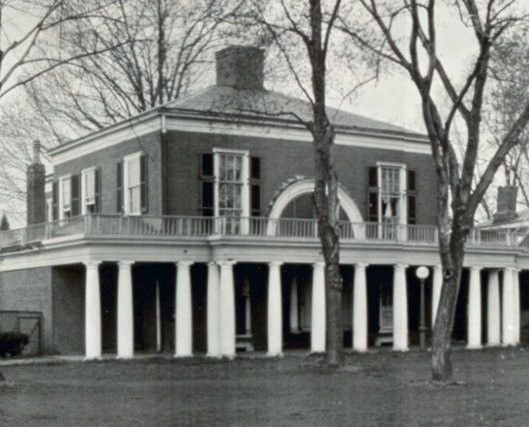
Pavilion IX Alcove
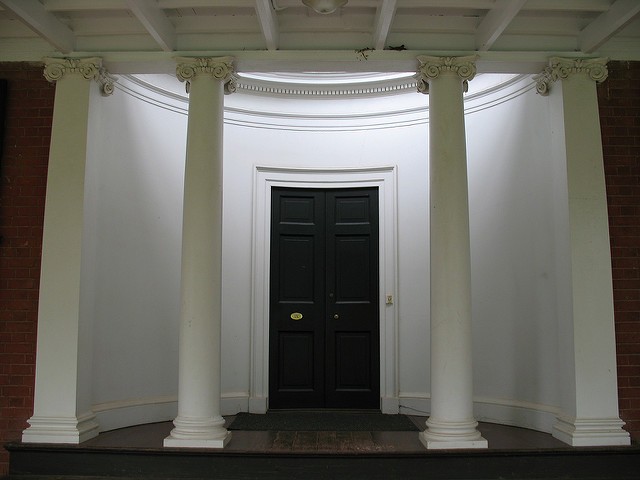
View from beneath the West Lawn colonnade of the entry columns, portico, and lunette of Pavilion IX
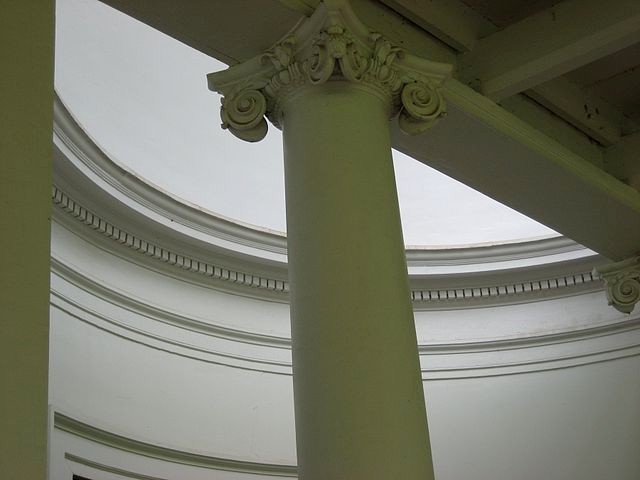
Garden and part of the back side of Pavilion IX
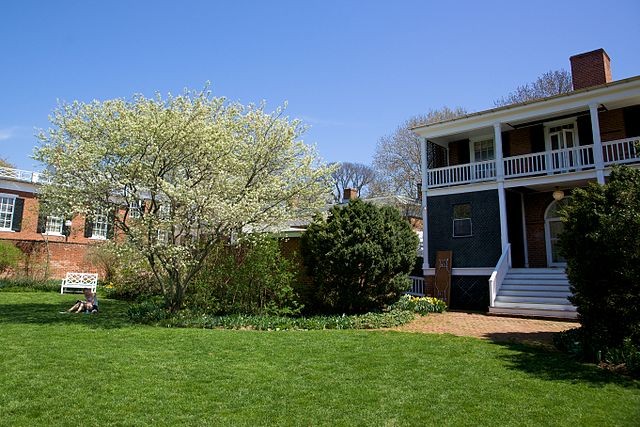
(Ca. 1804) Portrait of Benjamin Henry Latrobe by Charles Willson Peale
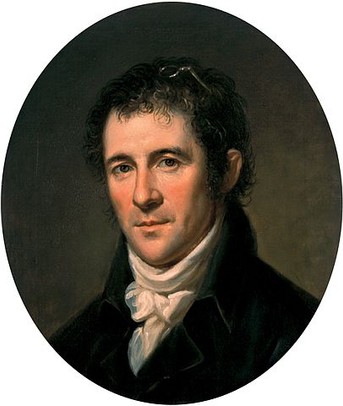
Backstory and Context
Text-to-speech Audio
Ten Pavilions are situated along the east and west sides of the University of Virginia's Academical Village. Centered around the Lawn, the Academical Village was designed by Thomas Jefferson as a unique environment where students and faculty could live and study. Each pavilion represents an academic discipline as conceived by Jefferson, an order of ancient architecture, and was intended to be occupied by a professor of the "useful science" with which it was associated. No two Pavilions in the Jeffersonian Precinct of the U.Va campus are exactly alike.
Situated on the western side of the Lawn, Pavilion IX is a unique structure in that it breaks from the traditional design and introduces the French Neo-classic style, which was popular in the early 18th Century. Jefferson collaborated heavily with Benjamin Henry Latrobe, the first professionally trained architect in the United States, in the design of both Pavilion IX and the Rotunda. Latrobe was also Jefferson's Surveyor of Public Buildings.
Pavilion IX was intended to adapt the Ionic order based on the Temple of Fortuna virilis of Palladio. Jefferson prepared studies for the elevation and floor plans on a piece of engraved graph paper. A notation at the top features the name "Latrobe," suggesting the architect's involvement in the design of the facade (which incorporates an entrance niche). Construction was underway by the autumn of 1820. The work was done by individuals also involved in the construction and decoration of the other Pavilions, such as A.H. Brooks (who did the tin roofing) and William J. Coffee (the sculptor charged with decorating the interior, most likely the frieze in the professor's parlor on the second floor).
The first occupant of Pavilion IX was George Tucker, Professor of Ethics and author of the first American science fiction novel, A Voyage to the Moon, which he wrote after taking up residence here in 1825. Another notable resident was Reverend William McGuffy, author of McGuffey's Eclectic Readers. The garden of Pavilion IX once featured an ash tree said to have been planted by McGuffy. The ash tree lived over a century until it died of old age in 1990. A scion was planted in its place.
Numerous small modifications have been made to Pavilion IX since it was built. Recently, in 2007, the University and Mesick-Cohen-Wilson-Baker Architects undertook a detailed study into the building's "Chinese"-style rails. The findings of this report were used to recreate the original rails from Jefferson's time, which would serve as a prototype for a full restoration of the Lawn's Chinese rails. The 2007 work replaced 1976 wood railings based on historic images, which themselves replaced a 19th-Century, Gothic Revival cast-iron balustrade.
Situated on the western side of the Lawn, Pavilion IX is a unique structure in that it breaks from the traditional design and introduces the French Neo-classic style, which was popular in the early 18th Century. Jefferson collaborated heavily with Benjamin Henry Latrobe, the first professionally trained architect in the United States, in the design of both Pavilion IX and the Rotunda. Latrobe was also Jefferson's Surveyor of Public Buildings.
Pavilion IX was intended to adapt the Ionic order based on the Temple of Fortuna virilis of Palladio. Jefferson prepared studies for the elevation and floor plans on a piece of engraved graph paper. A notation at the top features the name "Latrobe," suggesting the architect's involvement in the design of the facade (which incorporates an entrance niche). Construction was underway by the autumn of 1820. The work was done by individuals also involved in the construction and decoration of the other Pavilions, such as A.H. Brooks (who did the tin roofing) and William J. Coffee (the sculptor charged with decorating the interior, most likely the frieze in the professor's parlor on the second floor).
The first occupant of Pavilion IX was George Tucker, Professor of Ethics and author of the first American science fiction novel, A Voyage to the Moon, which he wrote after taking up residence here in 1825. Another notable resident was Reverend William McGuffy, author of McGuffey's Eclectic Readers. The garden of Pavilion IX once featured an ash tree said to have been planted by McGuffy. The ash tree lived over a century until it died of old age in 1990. A scion was planted in its place.
Numerous small modifications have been made to Pavilion IX since it was built. Recently, in 2007, the University and Mesick-Cohen-Wilson-Baker Architects undertook a detailed study into the building's "Chinese"-style rails. The findings of this report were used to recreate the original rails from Jefferson's time, which would serve as a prototype for a full restoration of the Lawn's Chinese rails. The 2007 work replaced 1976 wood railings based on historic images, which themselves replaced a 19th-Century, Gothic Revival cast-iron balustrade.
Sources
John G. Waite Associates, Architects pllc. "University of Virginia IX Historic Structure Report." 2010. Accessed April 5, 2017. http://www.officearchitect.Virginia.edu/pdfs/Pavilion_IX_HistoricStructureReport.pdf.
Sullivan, Mary Ann. "Images of The Lawn, University of Virginia, by Thomas Jefferson." Bluffton. Accessed April 4, 2017. http://www.bluffton.edu/homepages/facstaff/sullivanm/Virginia/charlottesville/uvalawn/lawn.html.
"The Lawn." Wikipedia, the Free Encyclopedia. Accessed March 23, 2017. http://en.wikipedia.org/wiki/The_Lawn.
"U.Va. Web Map: Pavilion IX." The University of Virginia. Accessed April 4, 2017. http://www.Virginia.edu/webmap/popPages/pavilion9.html.
Pavilion IX in 1911; image by Holsinger, Rufus W., 1866-1930, Public Domain, https://commons.wikimedia.org/w/index.php?curid=5290037.
UVA Alcove in Pavilion IX; image by Mr.TinDC via Flickr Creative Commons, https://www.flickr.com/photos/mr_t_in_dc/2690418765.
Detail View of Pavilion IX Columns; image by Timothy Jarrett - originally posted to Flickr as Curve, CC BY-SA 2.0, https://commons.wikimedia.org/w/index.php?curid=4012710.
UVA Garden; image by Karen Blaha - Flickr: UVA garden, CC BY-SA 2.0, https://commons.wikimedia.org/w/index.php?curid=12972186.
Sullivan, Mary Ann. "Images of The Lawn, University of Virginia, by Thomas Jefferson." Bluffton. Accessed April 4, 2017. http://www.bluffton.edu/homepages/facstaff/sullivanm/Virginia/charlottesville/uvalawn/lawn.html.
"The Lawn." Wikipedia, the Free Encyclopedia. Accessed March 23, 2017. http://en.wikipedia.org/wiki/The_Lawn.
"U.Va. Web Map: Pavilion IX." The University of Virginia. Accessed April 4, 2017. http://www.Virginia.edu/webmap/popPages/pavilion9.html.
Pavilion IX in 1911; image by Holsinger, Rufus W., 1866-1930, Public Domain, https://commons.wikimedia.org/w/index.php?curid=5290037.
UVA Alcove in Pavilion IX; image by Mr.TinDC via Flickr Creative Commons, https://www.flickr.com/photos/mr_t_in_dc/2690418765.
Detail View of Pavilion IX Columns; image by Timothy Jarrett - originally posted to Flickr as Curve, CC BY-SA 2.0, https://commons.wikimedia.org/w/index.php?curid=4012710.
UVA Garden; image by Karen Blaha - Flickr: UVA garden, CC BY-SA 2.0, https://commons.wikimedia.org/w/index.php?curid=12972186.
